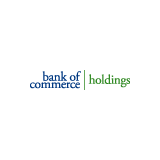
Bank of Commerce Holdings Financial Statements 2011-2025 | BOCH
Annual Financial Statements Bank of Commerce Holdings
| 2020 | 2019 | 2018 | 2017 | 2016 | 2015 | 2014 | 2013 | 2012 | 2011 | |
|---|---|---|---|---|---|---|---|---|---|---|
Market Cap |
169 M | 198 M | 178 M | 178 M | 132 M | 78.5 M | 76.8 M | 94.1 M | 80.6 M | 64.1 M |
Shares |
16.7 M | 18 M | 16.2 M | 15.2 M | 13.4 M | 13.3 M | 13.5 M | 14.9 M | 16.3 M | 17 M |
Net Income |
14.2 M | 15 M | 15.7 M | 7.34 M | 5.26 M | 8.59 M | 5.73 M | 7.94 M | 7.42 M | 7.26 M |
Revenue |
59.5 M | 57.7 M | 51.6 M | 46.2 M | 39.8 M | 37 M | 36.9 M | 37.3 M | 41.7 M | 51.9 M |
EBITDA |
21.3 M | - | - | - | - | - | - | - | - | - |
Operating Expenses |
40.8 M | 43 M | 37 M | 37 M | 37 M | 30 M | 34 M | 28 M | 35 M | 36 M |
General and Administrative Expenses |
24.5 M | 24.2 M | 21.6 M | 20.8 M | 19.5 M | 16 M | 16.9 M | 13.5 M | 12.9 M | 21.8 M |
All numbers in USD currency
Main types of financial statements Bank of Commerce Holdings BOCHFinancial statements are the primary tool companies use to inform stakeholders about their financial position, performance, and changes in capital structure. It is a kind of "business language" understood by investors, creditors, tax authorities, and other participants in the economic environment.
- Income Statement
Shows income, expenses, and resulting profit or loss over a specific period. Helps assess business profitability. - Balance Sheet
Reflects a company’s assets, liabilities, and equity as of a specific date. It’s a snapshot of what the company owns and owes.
Assets — everything the company owns (cash, equipment, buildings, accounts receivable, etc.).
Liabilities — debts and other external sources of financing.
Equity — owners' capital and retained earnings. - Cash Flow Statement
Reveals how the company earns and spends money in three areas: operating, investing, and financing activities.
- IFRS — International Financial Reporting Standards, applicable to public and multinational companies.
- GAAP — Generally Accepted Accounting Principles used in the United States.
- RAS — Russian Accounting Standards, used domestically in Russia.
Financial reporting Bank of Commerce Holdings plays a crucial role for investors as it serves as an objective source of information about a company's current state. Based on the reports, one can determine whether a company is growing, stagnating, or losing market share. This allows investors to identify both promising and problematic assets in a timely manner.
In addition, financial data provides a basis for forecasting future returns. Historical trends in revenue, profit, and cash flow help evaluate potential dividends, the likelihood of stock price growth, and overall investment risk.
Transparent and accurate reporting is also an indicator of a company’s maturity and managerial responsibility. Such openness builds investor confidence and simplifies investment decision-making, especially when comparing multiple companies.
Finally, financial statements enable high-quality comparative analysis. They allow companies to be evaluated against each other in terms of profitability, debt levels, margins, and other key metrics — which is particularly important when choosing the best investment options within an industry or market segment.
 Facebook
Facebook X
X Telegram
Telegram